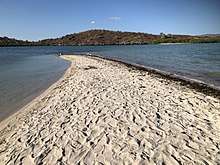San Ignacio Lagoon
San Ignacio Lagoon (Laguna San Ignacio) is a lagoon located in Mulegé Municipality of the Mexican state of Baja California Sur, 59 kilometres (37 mi) from San Ignacio, Mexico and Highway 1. It is one of the winter sanctuaries of the eastern Pacific gray whales (Eschrichtius robustus).

| Designations | |
|---|---|
| Official name | Laguna San Ignacio |
| Designated | 2 February 2004 |
| Reference no. | 1341[1] |
History
San Ignacio Lagoon was originally discovered by whaling captain Jared Poole, brother-in-law to captain Charles Melville Scammon. The first whaling expedition to San Ignacio Lagoon occurred in 1860 led by Scammon and six whaling vessels. Although many whaling captains would not risk losing their ships to the treacherous sand bar shoals and narrow shallow water passage into the lagoon, enough bold whaling captains did and the beginning of the near extinction of the Pacific gray whale. The lagoon is now one of the primary destinations of the gray whale migration.
Facts about San Ignacio Lagoon
With a local community of less than 100 inhabitants, residents depend upon fishing and whale watching as their primary means of support. The lagoon stretches sixteen miles into the desert and has a maximum width of five miles. The lagoon is divided into three sections: The upper lagoon is the shallowest and is the birthing area where pregnant females bear their young. The middle lagoon is the corridor where mothers travel with their newborn calves to the lower lagoon. The lower lagoon is where the majority of cetaceans reside and where most of the social behavior occurs. Here, males and females congregate looking for mates and newborn calves prepare themselves for the long journey north to their summer feeding grounds in the Arctic.
San Ignacio Lagoon's significance to the world community
In 1988 Mexico established the El Vizcaíno Biosphere Reserve to include San Ignacio Lagoon, which is Latin America's largest wildlife sanctuary. Not only is San Ignacio lagoon a gray whale sanctuary, but it is one of only two undeveloped nursery and breeding ground in the world of the Pacific gray whale. The other is just 4 hours away in Magdalena Bay. San Ignacio lagoon is also the critical habitat for the nearly extinct berrendo or pronghorn antelope and an important feeding habitat for four of the worlds seven species of sea turtles: leatherbacks, hawksbills, green turtles and olive ridleys (all endangered). In 1993 the United Nations declared San Ignacio lagoon a World Heritage site because of its importance to the world community.